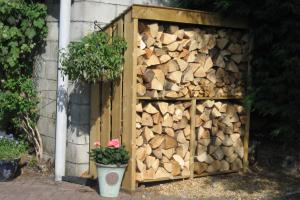Ultimate Guide on How to Dry Firewood for Optimal Burning

-
Quick Links:
- Introduction
- Why Dry Firewood?
- Understanding Firewood Moisture Content
- Methods of Drying Firewood
- Storing Dried Firewood
- Tips for Accelerating the Drying Process
- Case Studies
- Expert Insights
- FAQs
- Conclusion
Introduction
Dry firewood is essential for effective burning, whether for heating your home or for a cozy campfire. In this comprehensive guide, we will explore the importance of drying firewood, methods to achieve it, and tips to ensure that your firewood is seasoned correctly for optimal performance.
Why Dry Firewood?
Using dry firewood is crucial for several reasons:
- Efficient Burning: Dry firewood burns hotter and produces more heat, making it more efficient.
- Less Smoke: Wet wood produces more smoke and creosote, leading to chimney buildup and pollution.
- Ease of Ignition: Dry wood ignites easily and burns steadily, improving your overall experience.
Understanding Firewood Moisture Content
The moisture content of firewood is a critical factor that influences its burning characteristics. Ideally, firewood should have a moisture content of less than 20% for optimal performance.
| Moisture Content (%) | Burning Characteristics |
|---|---|
| Less than 20% | Efficient burning, high heat output |
| 20% - 30% | Moderate burning, some smoke |
| Over 30% | Poor burning, excessive smoke |
Methods of Drying Firewood
There are several effective methods to dry firewood:
1. Air Drying
Air drying is the most common method, which involves stacking firewood in a well-ventilated area, away from direct ground moisture. Here's a simple step-by-step guide:
- Cut the wood into manageable lengths (16-18 inches).
- Stack the wood in a crisscross pattern to allow airflow.
- Cover the top of the stack with a tarp to protect it from rain, leaving sides open for air circulation.
- Allow the wood to dry for 6 months to a year, depending on the wood type.
2. Kiln Drying
Kiln drying is a faster method that involves using a controlled environment to reduce moisture content quickly. This method requires special equipment but is ideal for commercial operations.
3. Solar Drying
This method uses solar energy to heat the wood, speeding up the drying process. It requires a solar kiln or a simple greenhouse setup.
Storing Dried Firewood
Proper storage of dried firewood is equally important. Here are some key storage tips:
- Store firewood off the ground using pallets or racks.
- Keep the wood covered but well-ventilated to prevent moisture accumulation.
- Avoid stacking wood against walls where moisture can transfer.
Tips for Accelerating the Drying Process
To speed up the drying process, consider these strategies:
- Split the wood into smaller pieces to increase surface area.
- Stack wood in a sunny location to take advantage of natural heat.
- Use a fan or dehumidifier in damp climates to enhance airflow.
Case Studies
To understand the efficacy of these methods, let’s look at a couple of case studies:
Case Study 1: Family Use of Air Drying
A family in the Midwest used air drying for oak firewood. They found that after 9 months, the moisture content dropped to 15%, allowing them to heat their home efficiently during winter.
Case Study 2: Commercial Kiln Drying
A small business that sold firewood invested in a kiln drying operation. They reduced their drying time from 12 months to just 4 weeks, significantly increasing their profit margin.
Expert Insights
We consulted with firewood experts to gather tips on drying firewood:
"The key to great firewood is patience. Rushing the drying process can lead to poor burning characteristics," says John Smith, a seasoned woodworker.
FAQs
Here are some frequently asked questions regarding drying firewood:
1. How long does it take to dry firewood?
It typically takes 6 months to a year to properly dry firewood, depending on wood type and environmental conditions.
2. Can I burn unseasoned wood?
Burning unseasoned wood is not recommended as it produces more smoke and less heat, leading to inefficient burning.
3. What is the best wood for burning?
Hardwoods like oak, maple, and hickory are generally the best for burning due to their dense structure and high heat output.
4. How can I tell if my firewood is dry?
Dry wood has a lighter weight, makes a sharp sound when struck, and shows cracks on the ends.
5. Is it better to split firewood before drying?
Yes, splitting wood before drying helps it dry faster due to increased surface area.
6. Can I dry firewood in a garage?
While it's possible, ensure that there is sufficient airflow and low humidity to prevent mold growth.
7. What is the ideal moisture content for firewood?
The ideal moisture content for firewood is below 20% for efficient burning.
8. Should I cover my firewood stack?
Yes, covering the top while leaving the sides open helps protect from rain while allowing airflow.
9. How do I speed up the drying process?
Splitting the wood, stacking in a sunny spot, and using fans can all help speed up drying.
10. Can I use a microwave to dry firewood?
Microwaving small pieces of wood can reduce moisture content, but it’s not practical for larger quantities.
Conclusion
Drying firewood is an essential step in ensuring its effectiveness and efficiency. Whether you're a casual camper or a homeowner looking to stay warm in winter, understanding the methods and best practices for drying firewood will enhance your experience and provide you with the best results. By following the steps outlined in this guide, you can ensure your firewood is adequately dried and ready for optimal burning.
For more information on firewood drying, check out these resources:
- University of Minnesota Extension on Firewood Drying
- USDA Forest Service on Firewood
- Wood Magazine Firewood Tips
Random Reads